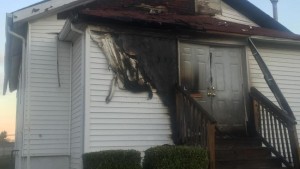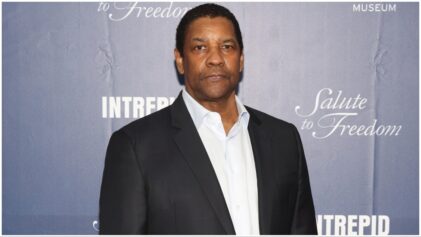
The damage sustained at New Life Missionary Baptist Church by a fire, the fifth black church in the area to be hit by arson in 10 days. IMAGE: ST. LOUIS FIRE DEPT.
Black churches are burning again, this time in St. Louis. Six churches have burned in two weeks in the metropolitan area, and this time, authorities seem to be paying attention.
According to local officials, the six fires set since October 8 appear to be connected, as they were all set in a church entryway or door, reports the New York Times. The latest church to fall prey to arson was the Ebenezer Lutheran Church, when parishioners arrived Sunday morning to discover the blaze.
A number of agencies such as the Federal Bureau of Alcohol, Tobacco and Firearms are investigating the incidents, and a $2,000 reward is being offered. No injuries have been reported, as the fires were set when the churches were not occupied. Further, the fires were set during different parts of the day, to churches of various denominations, and buildings ranging from small storefronts to larger, more sophisticated edifices. Damage to the churches has ranged from a few hundred dollars to near destruction according to CBS News, which also noted the churches are all within a few miles of each other in North St. Louis.
“We believe that this fire-setting activity is meant to send a message,” said a joint statement from the St. Louis Police and Fire Departments and the Bureau of Alcohol, Tobacco and Firearms. The statement did not specify what the message was.
“It is arson. That’s why law enforcement is involved in this entire investigation,” said Captain Garon Mosby of the St. Louis Fire Department.
“Churches are a place for worship. They’re a place of sanctuary,” St. Louis Mayor Francis Slay said. “Someone who would commit such a crime is atrocious.”
“These cowardly acts of violence against places of worship are deeply troubling,” said Missouri Gov. Jay Nixon. “Houses of worship must be safe havens where people can come together in faith and fellowship—not [become] the targets of hate and violence.”
Pastor Roderick Burton of the New Northside Missionary Baptist Church, whose front doors caught fire, told Vice News he believes the fires are connected, and he has not heard from neighboring churches or from the mayor’s office.
“One thing I am disappointed about is I haven’t heard anything from the rest of the faith community in terms of solidarity,” he said. “St. Louis is a racially divided city. If I was a white pastor, I would be more intentional about reaching out to a black church and being like, ‘Hey, we’re with you, we’re not for this,’ I haven’t heard anything. After all we went through regarding Ferguson, to me, any type of violence, it should be addressed from the top.”
In the past year, the St. Louis area has been roiled in light of police violence, including the police shooting death of Michael Brown in Ferguson last year. Additionally, there has bee a recent focus on the racial profiling and economic exploitation of local Black residents by the police and court system. The #BlackLivesMatter movement gained momentum following the death of Michael Brown, and has called for an end to the killing of Black bodies by law enforcement as well as reform of the criminal justice system.
According to the Anti-Defamation League of St. Louis, while no racial motive has been established, “the fear and intimidation in the African-American community is substantial and must be validated.” In July, as Reuters noted, the organization raised similar concerns following a series of church burnings in the South after the massacre at Emanuel AME Church in Charleston, when a white supremacist opened fire and killed nine Black congregants during a Bible study group. Emanuel is an historic Black church with important significance to the African-American community, as it has stood as a symbol of Black struggle against oppression, and was part of the first independent Black denomination in the United States. Following its involvement in Denmark Vesey’s slave rebellion, the church was burned down by angry whites.
Throughout history, from slavery to the civil rights movement, up until today, the Black church has played a major role as a center of the Black community, a place of refuge, and a source of effective political organizing. It is for those reasons that white supremacists and domestic terrorists always targeted the Black church with acts of violence–a prominent example being the 1963 firebomb murder of four little girls at the Sixteenth Street Baptist Church in Birmingham, Alabama.
The purpose of such acts of violence have been to strike fear into the heart of the African-American community and kill its spirit and its activism.

